NVIDIA's success in 2005-2006, when it was launching products step by step ending up with GeForce 8800, turned the company's head and brought chaos. We have an impression that marketing specialists of this company forgot about primary needs, permanently celebrating victories over the competitor. I was told once that some companies build their entire business on the slogan to be better than their competitors. That is, not to develop innovations or think about users, but just to be better than the competitor. NVIDIA is a perfect example of this modus operandi.
Why think about users? The company rolled out GeForce 8800 GTS 320/640 MB with 96 processors and a 320-bit bus. Then the same product name was used for a card with 512 MB of memory, a 256-bit bus, and 128 processors. They don't care if users are confused - in fact, a 640 MB card is slower than a 512MB card, based on a new core. Both cards are called 8800 GTS. A little higher frequency, and we get 9800 GTX. And no one took pains to explain to users why the first number was incremented and the suffix was changed. The former should indicate a change of generations. It took a real revolution to change 7800 to 8800. While 8800 and 9800 differ by mere 25 MHz.
That's not all. Now the 8800 GS are be renamed into 9600 GSO, because the '8' digit is already an eyesore, and there are so many G92 rejects that they must be utilized. Again no one has explained to users that the 9600 GT has 64 processors and a 256-bit bus, while the 9600 GSO has 96 processors and a 192-bit bus. Besides, they are based on different cores.
The lesson taught by the 8800 GTS 640 and 8800 GTS 512 based on different cores was wasted. Why think about users? What's important is that AMD with its 3870 is left far behind, and only the 3870 X2 is still kicking.
To say nothing about the mess with the 8800 GT and 9800 GT. Plus the GT200 with a consequent rollout of cut-down products based on its rejects. That's a real mess.
Some of you may think that I'm exaggerating. However, many retailers share this opinion. Even NVIDIA already realizes what they have done.
Moreover, this mess is undeservingly corrupting user impression of some products and their value. For example, GeForce 9600 GT is a very good product for its price, performance and features. The problem is with lots of older products and the notorious 9600 GSO. But it still makes sense to examine new products based on 9600 GT.
Today we are going to take a look at at products made by Gainward and Forsa. The former is a well-known manufacturer, while the latter is a startup. I cannot say that it's super, but it manufactures good products for minimal prices possible. There are both pros and cons. Today we are going to examine one card from Forse that is already replacing the regular reference 9600 GT.
Graphics Cards
| Gainward BLISS 9600 GT PCX Golden Sample 1024MB |
- GPU: GeForce 9600 GT (G94)
- Interface: PCI-Express x16
- GPU frequencies (ROPs/Shaders): 700/1750 MHz (nominal - 650/1625 MHz)
- Memory frequencies (physical (effective)): 1000 (2000) MHz (nominal - 900 (1800) MHz)
- Memory bus width: 256bit
- Vertex processors: -
- Pixel processors: -
- Unified processors: 64
- Texture processors: 32 (BLF)
- ROPs: 16
- Dimensions: 190x100x33 mm (the last figure is maximum thickness of the graphics card).
- PCB color: green
- RAMDACs/TDMS: integrated into GPU.
- Output connectors: 2xDVI (Dual-Link), HDMI, Display-Port, Audio
- VIVO: not available
- TV-out: not available.
- Multi-GPU operation: SLI (Hardware).
|
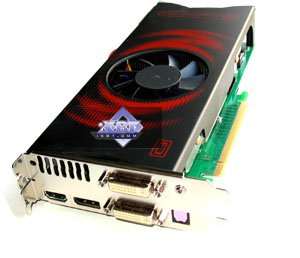
|
| Gainward BLISS 9600 GT PCX Golden Sample 512MB |
- GPU: GeForce 9600 GT (G94)
- Interface: PCI-Express x16
- GPU frequencies (ROPs/Shaders): 700/1750 MHz (nominal - 650/1625 MHz)
- Memory frequencies (physical (effective)): 1000 (2000) MHz (nominal - 900 (1800) MHz)
- Memory bus width: 256bit
- Vertex processors: -
- Pixel processors: -
- Unified processors: 64
- Texture processors: 32 (BLF)
- ROPs: 16
- Dimensions: 190x100x33 mm (the last figure is maximum thickness of the graphics card).
- PCB color: green
- RAMDACs/TDMS: integrated into GPU.
- Output connectors: 2xDVI (Dual-Link), HDMI, Display-Port, Audio
- VIVO: not available
- TV-out: not available.
- Multi-GPU operation: SLI (Hardware).
|
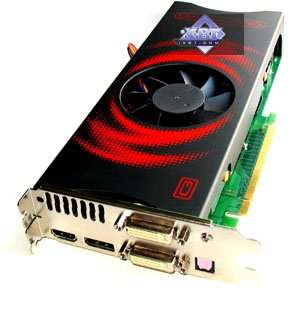
|
| Forsa GeForce 9600 GT 512MB (New edition) |
- GPU: GeForce 9600 GT (G94)
- Interface: PCI-Express x16
- GPU frequencies (ROPs/Shaders): 720/1800 MHz (nominal - 650/1625 MHz)
- Memory frequencies (physical (effective)): 1000 (2000) MHz (nominal - 900 (1800) MHz)
- Memory bus width: 256bit
- Vertex processors: -
- Pixel processors: -
- Unified processors: 64
- Texture processors: 32 (BLF)
- ROPs: 16
- Dimensions: 175x100x33 mm (the last figure is maximum thickness of the graphics card).
- PCB color: green
- RAMDACs/TDMS: integrated into GPU.
- Output connectors: 2xDVI (Dual-Link/HDMI), TV-Out.
- VIVO: not available
- TV-out: integrated into GPU.
- Multi-GPU operation: SLI (Hardware).
|
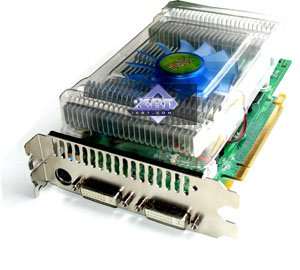
|
Gainward BLISS 9600 GT PCX Golden Sample 512MB
Forsa GeForce 9600 GT 512MB (New edition) |
| Each graphics card has 512 MB of GDDR3 SDRAM allocated in eight chips on the front side of the PCB.
Samsung memory chips (GDDR3). 1.0 ns memory access time, which corresponds to 1000 (2000) MHz. |

|
| Gainward BLISS 9600 GT PCX Golden Sample 1024MB |
| The graphics card has 1024 MB of GDDR3 SDRAM allocated in sixteen chips on the front and back sides of the PCB.
Samsung memory chips (GDDR3). 1.0 ns memory access time, which corresponds to 1000 (2000) MHz. |
 |
| Comparison with the reference design, front view |
| Forsa GeForce 9600 GT 512MB (New edition) |
Reference card NVIDIA GeForce 9600 GT |
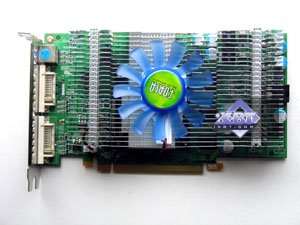
|

|
| Gainward BLISS 9600 GT PCX Golden Sample 1024MB |
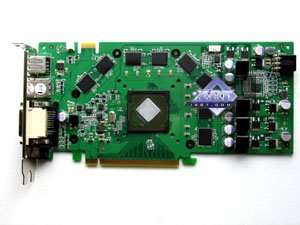
|
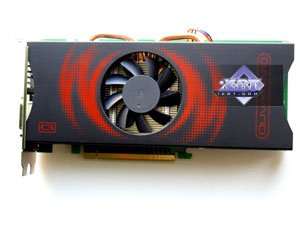
|
| Gainward BLISS 9600 GT PCX Golden Sample 512MB |
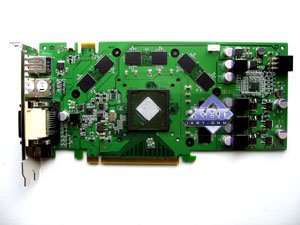
|
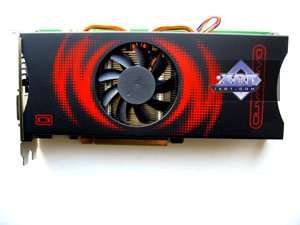
|
| Comparison with the reference design, back view |
| Forsa GeForce 9600 GT 512MB (New edition) |
Reference card NVIDIA GeForce 9600 GT |
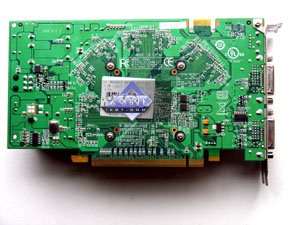 |

|
| Gainward BLISS 9600 GT PCX Golden Sample 1024MB |
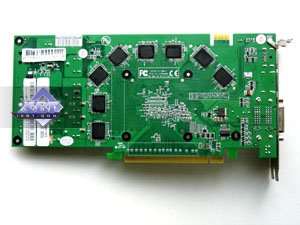 |
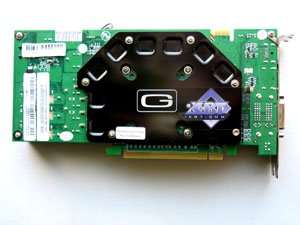 |
| Gainward BLISS 9600 GT PCX Golden Sample 512MB |
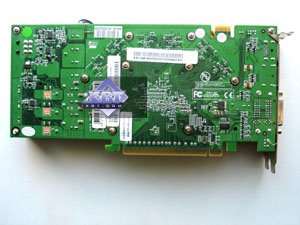 |
The photos above show that all the three cards differ from the reference design to this or that degree. The Forsa card has a tad shorter PCB, the additional power connector is shifted to the center of the card. And Gainward cards have unique PCB layouts, because they are equipped with special video outputs. Besides, one of the cards has a non-standard memory volume.
This change of design in Gainward cards has led to the disappearance of TV-Out, although this GPU has built-in support for this function. That's why only the card from Forsa has a TV-Out. It's an original jack. You will need a special bundled adapter to output video to a TV set via S-Video or RCA.
Analog monitors with D-Sub (VGA) interface are connected with special DVI-to-D-Sub adapters. What concerns video output through HDMI, Gainward cards possess such connectors. However, the Forsa card does not have a DVI-to-HDMI adapter in its bundle (these graphics cards potentially support full video-audio output to an HDMI receiver). So, you will have to buy this adapter to output signal through HDMI.
Maximum resolutions and frequencies:
- 240 Hz Max Refresh Rate
- 2048 x 1536 x 32bit x85Hz Max - analog interface
- 2560 x 1600 @ 60Hz Max - digital interface (all DVIs with Dual-Link)
What concerns MPEG2 playback features (DVD-Video), we analyzed this issue in 2002. Little has changed since that time. CPU load during video playback on modern graphics cards does not exceed 25%.
What concerns HDTV, a review is available here.
All cards require additional power supply, so each card is bundled with a molex to 6-pin adapter, even though all modern PSUs are equipped with these cables.
Write a comment below. No registration needed!
